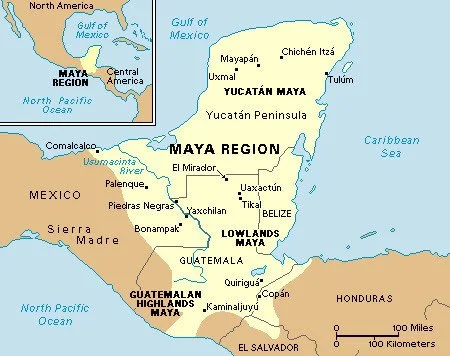The History of the Maya
Welcome to a digital expedition through the lush jungles and ancient city-states of the Maya, a civilization that carved its legacy amidst the mysteries of Mesoamerica. Our website is your gateway to unraveling the fascinating history of the Maya—an intricate tapestry woven with the brilliance of hieroglyphs, celestial observations, and architectural marvels.

Guided by historians, archaeologists, and researchers, our virtual journey explores the rise and flourishing of the Maya—from the sacred pyramids of Tikal to the celestial observatories of Copán. Immerse yourself in a curated collection of scholarly insights, historical analyses, and cultural narratives that unveil the grandeur, complexity, and enduring influence of the Maya civilization.
Discover groundbreaking research that delves into the intricate hieroglyphic writing, the mathematical precision of their calendars, and the cosmological insights embedded in their architecture. Whether you’re a history enthusiast, a student eager to delve into the past, or someone captivated by the wonders of ancient civilizations, our digital repository offers a comprehensive exploration of the captivating history of the Maya.
Engage with the ongoing dialogue that deepens our understanding of this remarkable civilization, where each stela, ceremonial ball court, and intricately carved jade artifact contributes to the story of a people whose cultural achievements continue to captivate and inspire. Welcome to a space where the scholarship on the history of the Maya thrives, inviting you to explore, learn, and marvel at the enduring legacy of this extraordinary Mesoamerican civilization.

The Maya civilisation flourished in the vast expanse of Mesoamerica, encompassing present-day southern Mexico, Guatemala, Belize, Honduras and El Salvador. This enigmatic civilisation, known for its advanced knowledge in mathematics, astronomy, architecture and hieroglyphic writing, thrived for nearly three millennia, leaving behind a rich legacy that continues to captivate scholars and enthusiasts alike.
The Maya emerged c. 2000 BC, with evidence of early settlements in the region. Divided into several city-states, they reached their zenith during the Classic period (c. 250-900 AD). This era witnessed the construction of impressive architectural complexes, such as the iconic cities of Tikal, Palenque and Chichen Itza, characterised by towering pyramids, palaces and intricate ceremonial centres. Trade networks connected the Maya to distant regions, facilitating the exchange of goods and ideas.
Maya society was hierarchical, with a ruling elite composed of kings and nobles who held political and religious authority. The majority of the population engaged in agricultural pursuits, primarily cultivating maize, beans and squash. Social structure was rigid, encompassing priests, warriors, artisans, merchants and farmers. They had an intricate system of governance and law, with each city-state functioning independently under the rule of a divine king.

Religion played a central role in Maya life, permeating all aspects of society. The Maya believed in a complex pantheon of gods and goddesses who governed various natural forces and aspects of human life. Rituals, including bloodletting and human sacrifice, were performed to ensure the gods’ favour and maintain cosmic balance. Astronomy held significant importance and the Maya developed an elaborate calendar system to track celestial movements, aligning them with religious and agricultural events.
The Maya excelled in various artistic and intellectual endeavours. They developed a sophisticated writing system, utilising hieroglyphs to record historical events, religious texts and astronomical observations. Maya art showcased intricate stone carvings, vivid murals and elaborate sculptures, often depicting rulers, gods and mythological scenes. In mathematics, the Maya utilised a vigesimal (base-20) numeral system and made significant advancements, including the concept of zero and complex calculations.

Around the 10th c. AD, the Maya civilisation experienced a decline, marked by the abandonment of major cities and a decline in monumental construction. Various theories, including environmental degradation, warfare and socioeconomic factors, have been proposed to explain this decline.
Following the decline of the Classic period, the Maya civilisation entered the Postclassic period (c. 900-1521 AD). This era was marked by significant changes and transformations. Many of the major Classic cities were abandoned or experienced a decline in population, while new political entities emerged in different regions. The Postclassic period saw the rise of powerful city-states such as Mayapán and Tulum. These city-states, though smaller in scale compared to their Classic counterparts, still played important roles as centres of political and economic influence.

The Maya experienced increased contact and influence from external cultures during this period. The influence of central Mexican civilisations, particularly the Toltecs and later the Aztecs, became more prominent. This cultural exchange led to the adoption of new artistic styles, architectural elements and religious practices within Maya society.
Religious practices during the Postclassic period also underwent changes. While many traditional Maya religious beliefs and rituals persisted, there was an increasing syncretism with elements of the central Mexican religions. Deities from different cultures were incorporated into Maya pantheon, resulting in a blending of religious practices and cosmologies.

Despite these developments, the Maya faced increasing pressure from external forces. Around the 13th century, the northern Yucatán Peninsula witnessed the incursion of the Itza people, who established their dominance over the region. Additionally, the arrival of European explorers in the 16th century, particularly the Spanish, marked a significant turning point in Maya history.
The Spanish conquest and subsequent colonization brought about a swift and dramatic decline of the Maya civilisation. The conquest resulted in the destruction of many cities, the suppression of indigenous traditions and the introduction of new socioeconomic and political systems. Nevertheless, Maya culture persevered, adapting to new circumstances and continuing to maintain a distinct identity through the preservation of traditions, languages and customs.

The Maya civilisation left an indelible mark on the cultural landscape of Mesoamerica. From the grandeur of the Classic period to the changes and challenges of the Postclassic era, the Maya exhibited remarkable artistic, intellectual and architectural achievements. Despite the eventual decline and colonisation, the Maya people continue to celebrate their heritage and contribute to the cultural diversity of the region. The Maya civilisation stands as a testament to the enduring legacy of ancient civilisations and their ability to adapt and survive in the face of adversity.
